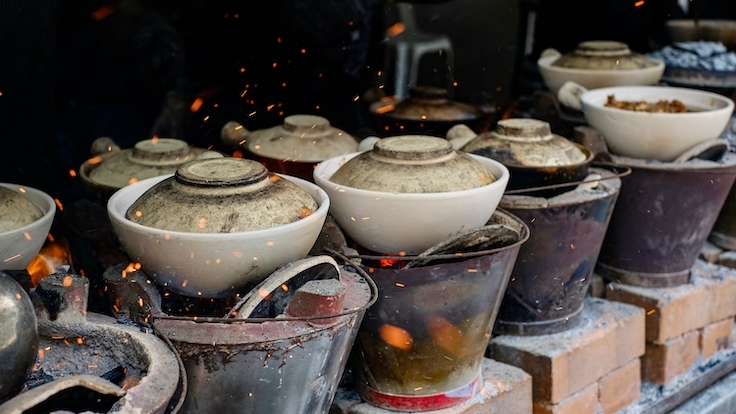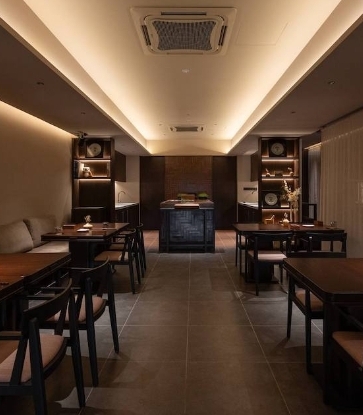Ever since the first Neanderthal extricated an animal carcass encased in a cooled volcanic lava bed, ate it, and pronounced it scrumptious, cooking in clay has been gaining credence with humans throughout the ages. Archaeological finding pointed to the Sumerians of Mesopotamia (3,500 BC) as having fashioned the first claypots in the world.

In China, the legendary Beggar’s Chicken is said to be an early example of cooking with clay, a forerunner of Chinese claypot cooking. Here, a leaf-wrapped chicken was encased in wet clay, then buried in hot embers to bake. The ready-baked clay package, upon being unearthed, would be shattered to yield the delicious, cooked viand. But this approach also meant that fresh clay is needed for the next time. Thus, the invention of the claypot: the first instance of recyclable cookware in human history — for now, one can re-use the same (clay) vessel again and again.

Cooking using claypots can always be relied upon to produce meltingly soft meats and deep-flavoured gravies. As heat is diffused and spread evenly in the claypot, the process promotes slow, patient cooking that draws out the juices of the meats and vegetables.
Claypot Cooking in Malaysia and Singapore
Malaysian and Singaporean claypot cuisine is a culinary palimpsest that bears witness to the various culinary cultures that have contributed to our gastronomic world in one way or another. Claypot dishes always possess that romantic imagery: the rusticity of having the cooking vessel transferred straight from the stove onto the table with the contents still smoking hot. The lid will be ceremoniously lifted, releasing ephemeral wafts of aromatic deliciousness. Food served in a claypot always seems to taste better. Characteristically, the retained heat in a claypot will also ensure that the dramatic sizzling or bubbling continues for a while longer on the table, as the diners look on in anticipation, licking their chops, their appetites stirred.
Just mention “claypot” to any Malaysian or Singaporean, and these dishes will immediately come to mind:

Claypot Chicken Rice
Rice cooked in a claypot atop charcoal braziers are usually highly sought after for their smoky delicious aroma. The rice will be topped with marinated chicken pieces, which infuse the grains with their aroma and lend their juices to flavour the overall dish during the cooking process. Small pieces of salted fish will be added towards the end, to undercut the richness of the dish. Some claypot chicken rice eateries also offer a “mixed rice pot”, adding Chinese waxed sausages and waxed meats for an even richer result. But one must never forget one of the most important characteristics of a claypot chicken rice meal: its prized crisp, golden rice-crust (shades of Spanish “socarrat” in a paella pan) at the bottom of the pot!

Claypot Bak Kut Teh
One of the most popular soups in Singapore has to be the Teochew-style bak kut teh: luscious, fall-off-the-bone tender pork ribs slowly simmered with garlic and white peppercorns to obtain a savoury, peppery, utterly irresistible broth. Kuala Lumpur and Penang have their own take on the dish: Hokkien-style bak kut teh with its ambrosial dark, herbal broth.
But on both sides of the Causeway, a bak kut teh meal remains substantial in its offerings: with optional add-ons like pig’s kidney, tail, and other pig’s parts — plus mushrooms, vegetables, tofu, and beancurd sheets. The crisp Chinese cruller or youtiao (Chinese: 油條) is a must-have, to be dunked into the soup and enjoyed.
A claypot is a natural choice to serve bak kut teh in, as the Chinese like their soups piping hot. The residual heat in a hot claypot allows it to insulate the soup and keep it warm for much longer than porcelain or glass serving bowls, thus allowing the diners to enjoy their bak kut teh at a more leisurely pace.

Claypot Curry
In Malaysia and Singapore today, the popularity of claypot curries, cooked using fish head, seafood, or meats, spans all the main local culinary cultures: Indian, Chinese, and Malay alike. Indian cuisine traces its long association with claypot cooking all the way back to its early Indus Valley civilisation 5,000 years ago. Today, Indian fish head curry is a staple at Malaysia and Singapore’s slew of popular Indian banana leaf restaurants, and its appeal is such that even Chinese zi char places would often offer an impressive claypot of bubbling-hot fish head curry as the pièce de résistance at a dinner table spread.

Claypot Frog
This dish is an attractive pairing of Cantonese-style rice congee, served either plain or lightly-flavoured with frog’s legs, ginger, and scallions in one claypot, and Kung Pao frog’s legs (Chinese: 宫保田鸡) in another. Diners like to spoon the savoury-spicy Kung Pao sauce over their congee, resulting in an irresistible taste combination like no other.
The beauty of claypot lies in its versatility and its ability to transform and elevate any dish it contains to another level altogether. Claypot cooking’s universal appeal sees its continual relevance in today’s world — where one is as likely to see laksa noodles served in claypots in a neighbourhood kopitiam, as in a high-end Chinese restaurant presenting an elaborate Hakka poon choi in a basin-sized claypot.
Where to Enjoy Claypot Dishes in Singapore:
Eminent Frog Porridge & Seafood (Lor 19) (Bib Gourmand, MICHELIN Guide Singapore 2024)Lian He Ben Ji Claypot (Bib Gourmand, MICHELIN Guide Singapore 2024)
Na Na Curry (Bib Gourmand, MICHELIN Guide Singapore 2024)
New Lucky Claypot Rice (Bib Gourmand, MICHELIN Guide Singapore 2024)
Zhup Zhup (Bib Gourmand, MICHELIN Guide Singapore 2024)
Fu He Turtle Soup (Selected, MICHELIN Guide Singapore 2024)
Leon Kee Claypot Pork Rib Soup (Selected, MICHELIN Guide Singapore 2024)
Yong Kee Claypot Bak Kut Teh (Selected, MICHELIN Guide Singapore 2024)
Where to Enjoy Claypot Dishes in Kuala Lumpur & Penang:
Ah Hei Bak Kut Teh (Bib Gourmand, MICHELIN Guide Kuala Lumpur & Penang 2024)Heun Kee Claypot Chicken Rice (Pudu) (Bib Gourmand, MICHELIN Guide Kuala Lumpur & Penang 2024)
Hing Kee Bakuteh (Jalan Kepong) (Bib Gourmand, MICHELIN Guide Kuala Lumpur & Penang 2024)
Jalan Ipoh Claypot Chicken Rice (Bib Gourmand, MICHELIN Guide Kuala Lumpur & Penang 2024)
Lao San Tong Bah Kut Teh (Selected, MICHELIN Guide Kuala Lumpur & Penang 2024)



















